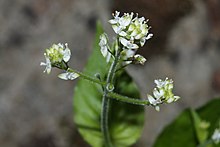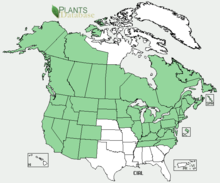Circaea alpina, commonly called alpine enchanter's nightshade, small enchanter's nightshade, or dwarf enchanter's nightshade is a 10–30 cm tall perennial herb found in cool forests of the Northern Hemisphere.[1][2][3]
| Enchanter's nightshade | |
|---|---|

| |
| Scientific classification | |
| Kingdom: | Plantae |
| Clade: | Tracheophytes |
| Clade: | Angiosperms |
| Clade: | Eudicots |
| Clade: | Rosids |
| Order: | Myrtales |
| Family: | Onagraceae |
| Genus: | Circaea |
| Species: | C. alpina
|
| Binomial name | |
| Circaea alpina | |

| |
| Range within North America | |
Description
editThe leaves are opposite, ovate, 2–6 cm and coarsely dentate. The 1.5–4 cm (0.6–1.6 in) petioles have a wing beneath. The flowers and fruits are clustered near the top of the fruiting raceme; each raceme bears 15 or less white or pink flowers in mid-May through early September.[4][5][6] Each flower has two white to light pink petals 1–1.5 mm (0.04–0.06 in) long with two lobes. The two white sepals are 1–2 mm (0.04–0.08 in) long.[4] The fruit is a small bur with one seed. C. alpina can reproduce vegetatively and via stolons.[2]
Distribution
editIn North America, Circaea alpina is distributed throughout all of Canada and North Carolina through Maine and New Mexico through Washington.[7][8] In Eurasia, the range of C. alpina includes Northern Europe south to Albania and Bulgaria and east to Korea and Japan.[1] C. alpina prefers a moist, upland habitat.[9] It is generally found in forests or near streams from sea level to 3,000 metres (10,000 ft).[7]
Hybrids
editCircaea alpina will hybridize with Circaea lutetiana producing sterile offspring that persists in vegetative colonies.[9]
References
edit- ^ a b "Species details : Circaea alpina". ITIS: Catalogue of Life. Archived from the original on 2016-08-14. Retrieved 2016-08-02.
- ^ a b "Alpine Enchanter's Nightshade". Naturegate. Archived from the original on 2023-03-15. Retrieved 2016-08-02.
- ^ "Circaea alpina (Alpine Enchanter's Nightshade)". www.minnesotawildflowers.info. Minnesota: Minnesota Environment and Natural Resources Trust Fund. 2024-07-20. Archived from the original on 2024-04-15. Retrieved 2024-08-13.
- ^ a b Klinkenberg, Brian, ed. (2014). "Circaea alpina". E-Flora BC: Electronic Atlas of the Plants of British Columbia [eflora.bc.ca]. Lab for Advanced Spatial Analysis, Department of Geography, University of British Columbia, Vancouver. Retrieved 2016-08-02.
- ^ Giblin, David, ed. (2015). "Circaea alpina". WTU Herbarium Image Collection. Burke Museum, University of Washington. Retrieved 2016-08-02.
- ^ "Circaea alpina". Jepson eFlora: Taxon page. Jepson Herbarium; University of California, Berkeley. 2015. Retrieved 2016-08-02.
- ^ a b Sullivan, Steven. K. (2015). "Circaea alpina". Wildflower Search. Retrieved 2016-08-02.
- ^ "Circaea alpina". PLANTS Database. United States Department of Agriculture; Natural Resources Conservation Service. 2015. Retrieved 2016-08-02.
- ^ a b Rhoads, Block (2007-09-05). The Plants of Pennsylvania (2 ed.). ISBN 978-0-8122-4003-0.
External links
edit- Media related to Circaea alpina at Wikimedia Commons
- Data related to Circaea alpina at Wikispecies